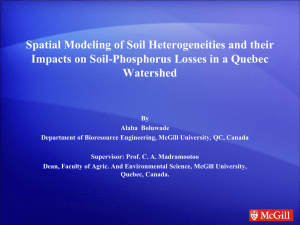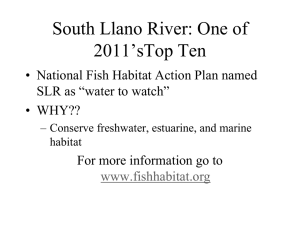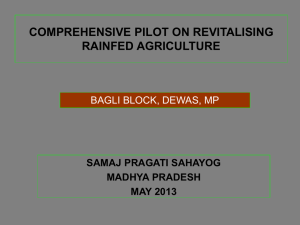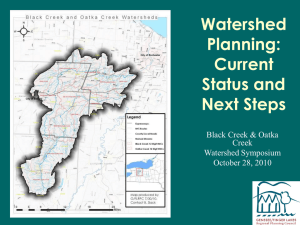Hydrological and Sediment yield Modeling in the Northern
advertisement
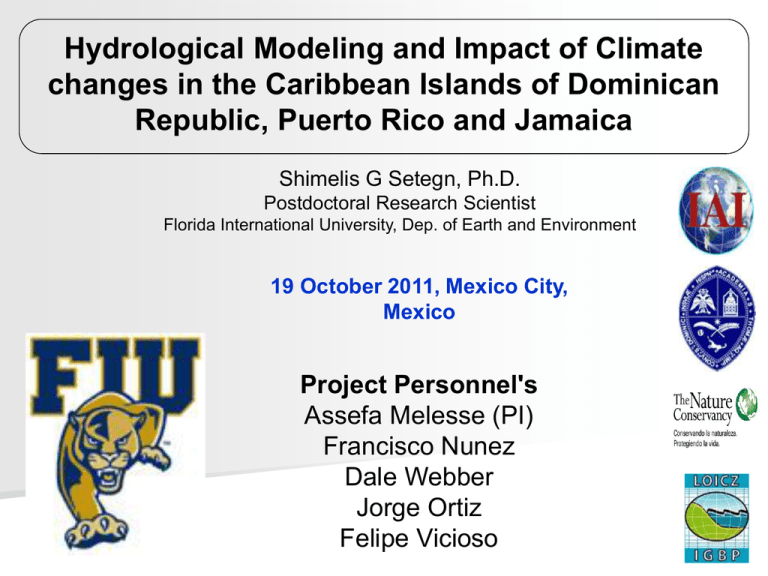
Hydrological Modeling and Impact of Climate changes in the Caribbean Islands of Dominican Republic, Puerto Rico and Jamaica Shimelis G Setegn, Ph.D. Postdoctoral Research Scientist Florida International University, Dep. of Earth and Environment 19 October 2011, Mexico City, Mexico Project Personnel's Assefa Melesse (PI) Francisco Nunez Dale Webber Jorge Ortiz Felipe Vicioso The presentation consists of CCS - Core Science Objectives Study area Modeling tools Modeling Results Climate change projections Impact of climate change on water resources Caribbean Coastal Scenarios Core Science Objectives Determine spatial and temporal variability in climate across the region. Determine geographic & demographic characteristics of catchments – topography, land cover, geology, soil, land management techniques, population, roads and infrastructure, urban systems, etc. Consider present & future trends in the nature & distribution of dynamic characteristics – e.g. land cover, management techniques, population, infrastructure, urban systems. Caribbean Coastal Scenarios Core Science Objectives (cont.) Simulate seasonal and inter-annual fluxes of fresh water, sediments, and dissolved loads to coastal zones as a function of climate and catchment characteristics. Montego Bay STUDY AREA Caribbean Costal Regions Puerto Rico Manate and Plata Basins Dominican Republic Haina and Yuna watersheds Jamaica Great River and Re Cobre Islands of interest Watershed Modeling Overview of Watershed modelling Many hydrological models are developed to describe the hydrology, erosion and sedimentation processes. They describe the physical processes controlling the transformation of precipitation to runoff and detachment and transport of sediments. Watershed models are used to implement alternative management strategies in the areas of – – – – – water resources allocation flood control impact of land use change impact of climate change environmental pollution control SWAT (Soil water Assessment Tool) SWAT is a river basin scale developed to predict the impact of land management practices on water, sediment and agricultural chemical yields It is a public domain model actively supported by the USDA Agricultural Research Service at the Grassland, Soil and Water Research Laboratory in Temple, Texas, USA. The SWAT system (ArcSWAT), geographic information system (GIS), embedded within can integrate various spatial environmental data, including soil, land cover, climate, and topographic features. SWAT cont. The model is physically based i.e., it requires specific information It is computationally efficient Simulation of very large basins SWAT impacts enables to study long-term Phases of hydrologic cycle simulated by SWAT Land phase Water phase Courtesy: SWAT Manual Model Input GIS input files needed for the SWAT model include the digital elevation model (DEM), land cover, and soil layers The DEM can be utilized by ArcSWAT to delineate basin and subbasin boundaries, calculate subbasin average slopes and delineate the stream network. The land use, soil and Slope layers are used to creat and define Hydrological response units (HRU’s). Model Input Cont. Metrological Data The weather variables for driving the hydrological balance are – precipitation, – air temperature, – solar radiation, – wind speed and – relative humidity. Model Input Cont. Hydrological data River Discharge and Suspended sediment load Land Management Management input files include planting, harvest, tillage operations, and pesticide and fertilizer application. Model Calibration and Evaluation The ability of a watershed model is evaluated through sensitivity analysis, model calibration, and model validation. For model evaluation we used the goodness of measures such as NSE, R2, MODELING RESULTS Puerto Rico, Rio Manati Time serious graph for calibration period – Rio Manati Annual average water balance of the Rio De Manati watershed Water balance Component Precipitation Surface runoff Lateral soil flow Groundwater flow (shallow aquifer) Revap (shallow aquifer => soil/plants) Annual Average (mm) 1620 86 386 3 102 Deep aquifer recharge 5 Total aquifer recharge 94 Total water yield Percolation out of soil 474 89 Actual evapotranspiration 1067 Potential evapotranspiration 1838 Average Monthly Basin Values of Manati watershed MONTH RAIN, SURF Q, Water Yield, ET, PET, S (mm) (mm) LAT Q (mm) (mm) (mm) 1 108.76 4.17 32.9 38.29 67.41 101.33 2 3 88.83 101.83 5.01 26.28 4.81 22.5 32.13 27.64 76.37 118.21 121.58 184.68 4 151.33 7.36 23.39 30.89 116.1 172.32 5 118.01 3.19 26.49 29.68 118.83 188.35 6 61.9 0.93 19.67 20.61 98.55 203.88 7 76.59 0.97 14.98 15.94 76.01 204.73 8 145.36 2.99 20.23 23.2 73.26 172.56 9 187.47 7.18 32.94 40.08 87.54 148.13 10 272.15 29.28 56.65 85.78 87.8 129.2 11 178.87 13.44 61.68 75 79.9 117.38 12 131.44 6.57 48.81 55.29 69.08 97.17 Puerto Rico – Plata Area (%) 0.003 4.141 28.387 1.295 0.225 0.612 51.078 0.107 13.015 0.011 1.127 Land use: Plata Watershed, PR Time serious graph for calibration period – Rio Plata Dominican Republic - Rio Haina Area 1.279 46.922 17.800 10.244 0.027 4.916 0.012 0.296 17.568 0.936 Land use: Haina Watershed, DR Days (1985-1987) Dec/87 Nov/87 Oct/87 Sep/87 Aug/87 Jul/87 Jun/87 May/87 Apr/87 Mar/87 Feb/87 Jan/87 Dec/86 Nov/86 Oct/86 Sep/86 Obsreved Aug/86 Jul/86 Jun/86 May/86 Apr/86 Mar/86 Feb/86 Jan/86 Dec/85 Nov/85 Oct/85 Sep/85 Aug/85 Jul/85 Jun/85 May/85 Apr/85 Mar/85 Feb/85 Jan/85 Discharge (m3/s) Time serious graph for calibration period – Haina Watershed Simulated 1200 1000 800 600 400 200 0 Annual average water balance of the Haina watershed Water balance Component Precipitation Surface runoff Lateral soil flow Groundwater flow (shallow aquifer) Revap (shallow aquifer => soil/plants) Annual Average (mm) 2101 927,63 21 215 17 Deep aquifer recharge 12.33 Total aquifer recharge 246.64 Total water yield Percolation out of soil 1161.63 250.31 Actual evapotranspiration 890.6 Potential evapotranspiration 1702 Jamaica, Great River Basin Time series of observed and simulated monthly flow for calibration (top) and validation (bottom) period at Lethe station of Great River Jamaica, Rio Cobre Watershed The time-series comparison between measured and simulated monthly flow at Rio Cobre Watershed Annual average water balance of the Rio Cobre watershed (1997-2008). Water balance Component Precipitation Annual Average (mm) 1953.0 Surface runoff 102.8 Lateral soil flow 427.7 Groundwater flow (shallow aquifer) 368.8 Revap (shallow aquifer => soil/plants) 9.0 Deep aquifer recharge 19.9 Total aquifer recharge 397.6 Total water yield 899.0 Percolation out of soil 393.5 Actual evapotranspiration 1028.3 Potential evapotranspiration 1579.8 Monthly mean and seasonal water balance components for the Rio Cobre watershed Seasons/months Rainfall Surface Lateral Water AET, PET, , mm flow, mm Yield, mm mm runoff, mm Average (1997-2008) mm 154.44 21.68 38.10 79.73 71.50 180.42 Dry (Jan-Mar) 57.72 4.20 11.67 28.24 68.12 180.33 Wet (Aug-Oct) 267.09 52.20 72.15 151.99 77.49 179.79 Spatial distribution of actual evapotranspiration in the Rio Cobre Watershed, Jamaica. Spatial distribution of water yield in the Rio Cobre Watershed, Jamaica. Climate Change 30 August 2010, Gran Melia, Puerto Rico, photo by Shimelis S Climate Change Impact on Water Resources Variability • GCM’s are numerical coupled models that represent various earth systems including the atmosphere, oceans, land surface and seaice and offer considerable potential for the study of climate change and variability. Climate change scenarios • Scenarios are images of the future, or alternative futures. They are neither predictions nor forecasts. • The Special Report on Emissions Scenarios (SRES) are grouped into four scenario families (A1, A2, B1 and B2) that explore alternative development pathways, covering a wide range of demographic, economic and technological driving forces and resulting GHG emissions. Center Model Atmospheric resolution (approx) AOM 4x3 4 x 3 Goddard Institute for Space Studies (GISS), NASA, USA GISS_ModelE-H 4 x 5 Canadian Centre for Climate Modelling and Analysis (CCCma) Coupled Global Climate Model (CGCM3) Hadley Centre for Climate Prediction and Research, Met Office United Kingdom Hadley Centre Global Environmental Model, version 1 (HadGEM1) 1.25 x 1.875 Bjerknes Centre for Climate Research Norway (BCCR) Bergen Climate Model (BCM2.0) 2.8×2.8 Canadian Center for Climate Modelling and Analysis Canada (CCCMA) Coupled Global Climate Model (CGCM3) 3.75× 3.7 Centre National de Recherches Meteorologiques France(CNRM) CNRM-CM3 2.8× 2.8 Australia's Commonwealth Scientific and Industrial Research Organisation Australia (CSIRO) Australia's Commonwealth Scientific and Industrial Research Organisation Australia (CSIRO) Max-Planck-Institut for Meteorology Germany (MPI-M) CSIRO Mark 3.0 1.9× 1.9 CSIRO Mark 3.5 1.9× 1.9 ECHAM5/MPI-OM 1.9× 1.9 Meteorological Institute of the University of Bonn (Germany), (MIUB) ECHO-G 3.75× 3.7 Geophysical Fluid Dynamics Laboratory USA ( GFDL) CM2.0 - AOGCM 2.5× 2.0 Geophysical Fluid Dynamics Laboratory USA (GFDL) Institute for Numerical Mathematics Russia (INM) Institut Pierre Simon Laplace France (IPSL) Meteorological Research Institute Japan (MRI) National Centre for Atmospheric Research USA (NCAR) CM2.1 - AOGCM INMCM3.0 IPSL-CM4 MRI-CGCM2.3.2 Parallel Climate Model (PCM) 2.5× 2.0 5.0× 4.0 3.75× 2.5 2.8× 2.8 2.8× 2.8 National Centre for Atmospheric Research USA(NCAR) Community Climate System Model, version 3.0 (CCSM3) HadCM3 1.4× 1.4 NASA Goddard Institute for Space Studies (NASA/GISS), USA, Hadley Centre for Climate Prediction and Research, Met Office, United Kingdom - UK Met. Office UK (UKMO) 3.75× 2.5 Trends in Climate Change - Temperature 4.5 4 3.5 3 2.5 2 1.5 1 0.5 0 A2 (2011-2040) A2 (2041-2070 A2 (2071-2100) 4 3 2 1 A1B (2011-2040) 0 A1B (2041-2070) A1B (2071-2100) 3 2.5 2 1.5 1 0.5 0 B1 (2011-2040) B1 (2041-2070) B1 (2071-2100) Trends in Climate Change - Rainfall 30 20 10 0 -10 -20 -30 -40 -50 -60 -70 30 20 10 0 -10 -20 -30 -40 -50 -60 -70 30 20 10 0 -10 -20 -30 -40 -50 A2 (2011-2040) A2 (2041-2070) A2 (2071-2100) A1B (2011-2040) A1B (2041-2070) A1B (2071-2100) B1 (2011-2040) B1 (2041-2070) B1 (2071-2100) Projected Seasonal changes in Rainfall Changes in stream flow due to changes in precipitation and air temperature for the period 2046-2065 and 2080-2100 Changes in potential and actual evapotranspiration (PET and AET) for the 2046-2065 Annual changes in potential and actual evapotranspiration (PET and AET) for the 2080-2100 Annual changes in soil water storage for 2046-2065 and 2080-2100 period Changes in surface and ground water for 2046-2065 and 2080-2100 periods Changes in surface and ground water for 2046-2065 and 2080-2100 periods Uncertainties in GCM model outputs A2 (2011-2040) 1.8 bccr_bcm2_0 1.6 cccma_cgcm3_1 T change in °C 1.4 cnrm_cm3 1.2 1 csiro_mk3_0 0.8 csiro_mk3_5 0.6 gfdl_cm2_0 0.4 gfdl_cm2_1 0.2 giss_model_e_r 0 Jan Feb Mar Apr May Jun Jul Aug Sep Oct Nov Dec ingv_echam4 Rainfall changes in % - A2 (2011-2040) Rainfall changes in % 100 bccr_bcm2_0 80 cccma_cgcm3_1 60 cnrm_cm3 40 20 csiro_mk3_0 0 csiro_mk3_5 -20 gfdl_cm2_0 -40 gfdl_cm2_1 -60 giss_model_e_r -80 Jan Feb Mar Apr May Jun Jul Aug Sep Oct Nov Dec ingv_echam4 Thank You! 30 August 2010, Puerto Rico

